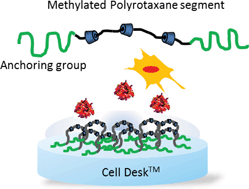ABA block copolymers composed of highly methylated polyrotaxane and hydrophobic anchoring terminal segments containing 2-methacryloyloxyethyl phosphorylcholine (MPC) and n-butyl methacrylate (PMB) (OMe-PRX-PMB) were synthesized as a platform of molecularly dynamic biomaterials. A contact angle measurement indicated that polymer surfaces with higher molecular mobility factors (Mf) estimated from quartz crystal microbalance with dissipation (QCM-D) measurements showed more significant changes in hydrophilicity in response to an environmental change between air and water; the OMe-PRX-PMB surface showed the highest Mf among the prepared polymer surfaces. Fibrinogen adsorption and its conformational analysis estimated by QCM-D and enzyme-linked immunosorbent assay revealed that large amounts of fibrinogen adsorption occurred in a soft manner on the OMe-PRX-PMB surface and that the antibody binding to the C-terminus of the fibrinogen γ chains responsible for platelet adhesion and activation decreased as the Mf value increased. Furthermore, it was found that the OMe-PRX-PMB surface showed low platelet adhesion and high fibroblast adhesion, suggesting that molecular movement on biomaterial surfaces could be one of the key parameters in the regulation of a non-specific biological response.
